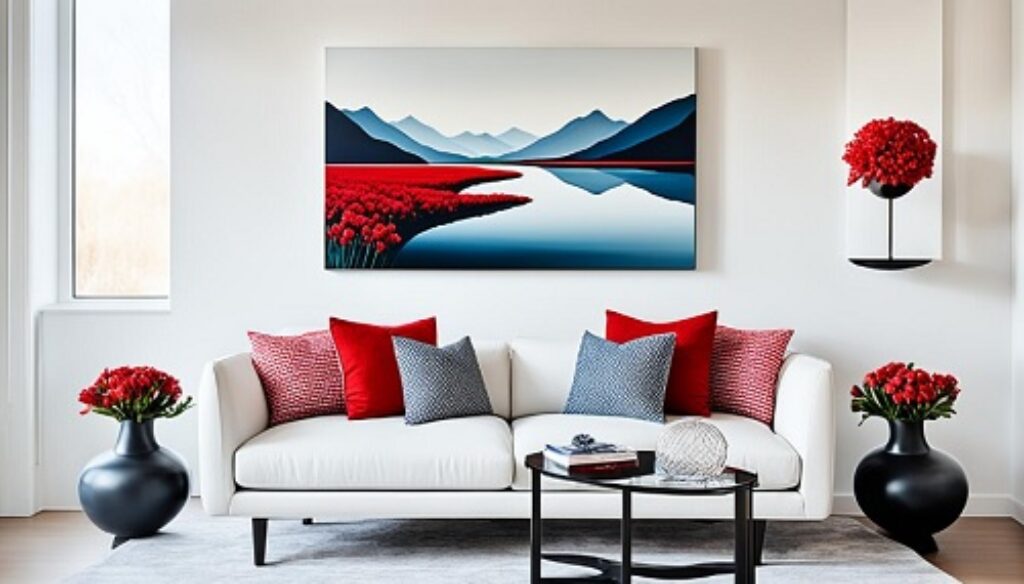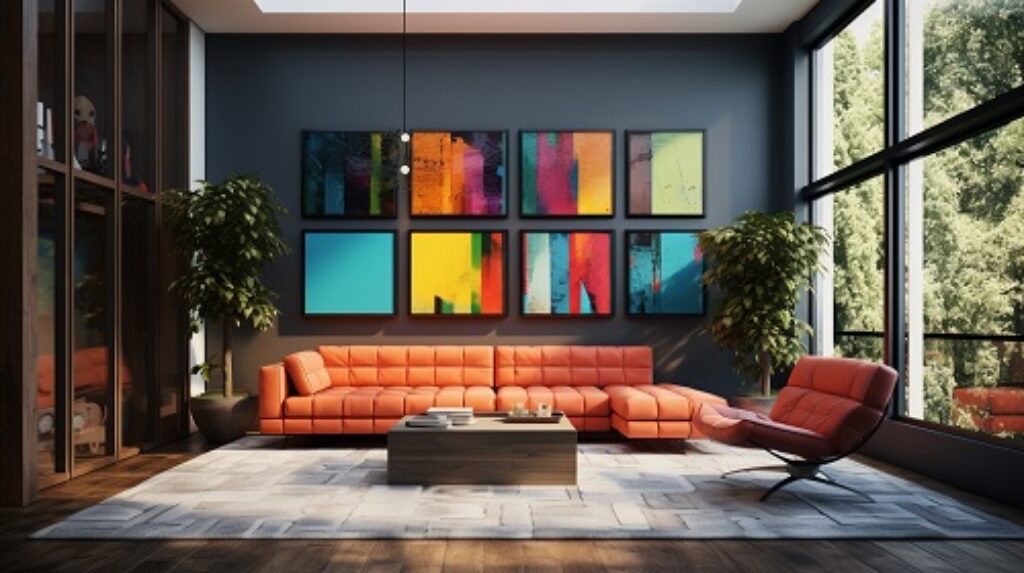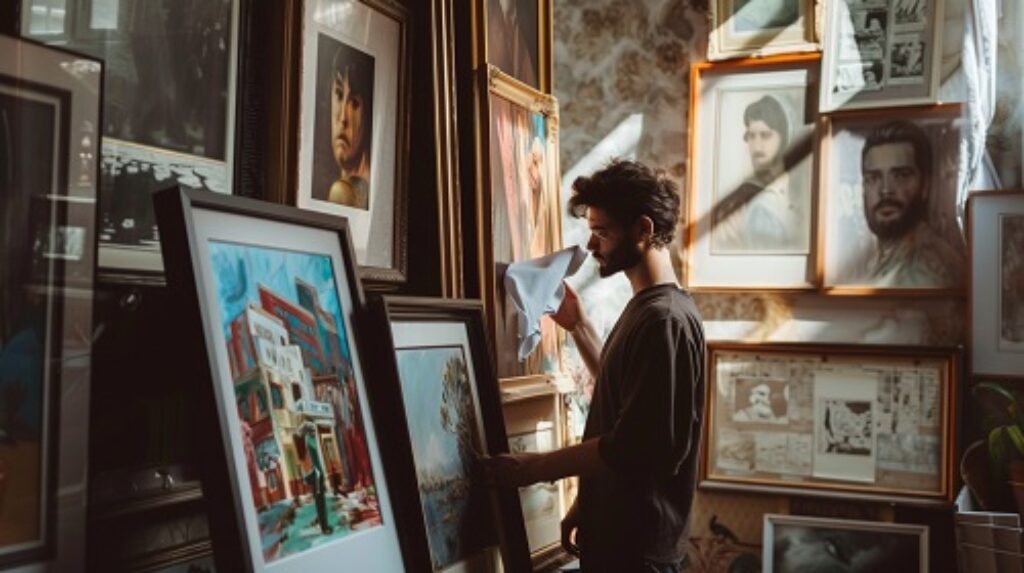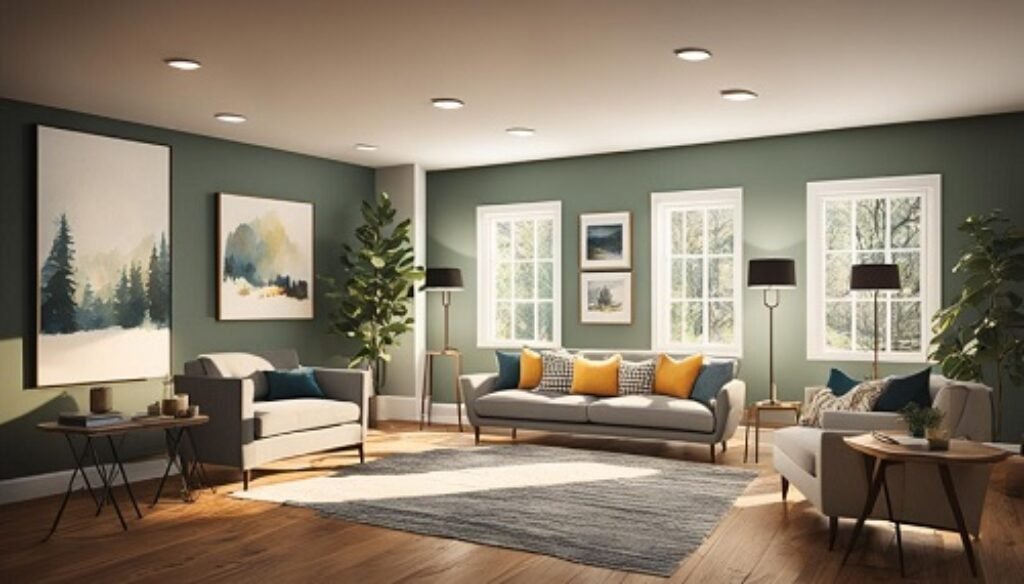Introduction:
Did you know that the right art can completely transform the ambiance of your home? The right art may make all the difference in creating a warm and inviting ambiance or a modern, streamlined appearance. Art can personalize your place and make it look good.
In this article, I will delve into the importance of art in home transformation and how interior designers can guide you in selecting the perfect pieces. We will explore different interior design styles and how art can enhance and complement each one. Additionally, we’ll explore art’s emotional and psychological effects on a room and its significance in expressing personal style and taste. Top interior designers advise on choosing, incorporating, and displaying art, as well as exploring diverse design forms.

Key Takeaways:
- Choosing the right art can completely transform your home’s ambiance.
- Interior designers play a crucial role in guiding art selection.
- Understanding different interior design styles helps you choose art that complements your desired aesthetic.
- Art impacts the overall aesthetics of a space, evokes emotions, and expresses personal style.
- Tips from top interior designers can help you make informed art selections and effectively display your chosen pieces.
Art has the remarkable ability to transform the ambiance of a home, creating a space that is not only visually appealing but also deeply personal. The carefully chosen pieces of art can evoke emotions, serve as focal points, and infuse a room with personality. In this section, we will explore the importance of art in home transformation and how interior designers play a pivotal role in guiding art selection.
A. Importance of art in transforming a home’s ambiance
Art holds the power to completely transform the ambiance of a home. Whether it’s a vibrant painting, a striking sculpture, or a captivating photograph, art can ignite emotions and breathe life into a space. The right artwork can create a sense of harmony and cohesiveness, tying together the various elements of a room. It can draw the eye, spark conversation, and make a lasting impression on anyone who enters the space.
B. Role of interior designers in guiding art selection
Interior designers play a crucial role in guiding art selection for a home. With their expert knowledge of design principles, aesthetics, and overall vision, interior designers have the unique ability to curate art collections that perfectly complement the style, color palette, and theme of a room. They help homeowners navigate the vast world of art, providing valuable insights and recommendations that align with the homeowner’s personality and preferences. From selecting the right pieces to advising on optimal placement and installation, interior designers ensure that the chosen artwork seamlessly integrates into the overall design scheme, amplifying its impact.
Understanding Different Interior Design Styles
To choose the correct art for your home, it’s important to have an understanding of different interior design styles. This section will provide a brief overview of popular interior design styles and describe the key characteristics of each style. Additionally, we will explore how art can enhance and complement different design styles.
A. Brief Overview of Popular Interior Design Styles
There are several popular interior design styles that homeowners can choose from. Some of the most common styles include:
- Minimalist
- Contemporary
- Traditional
- Classic
- Rustic
- Bohemian
- Eclectic
- Global-inspired
- Industrial
- Modern Farmhouse
Each style has its own unique characteristics and aesthetic, creating distinct atmospheres within a space. By familiarizing yourself with these styles, you can make informed decisions when selecting art for your home.
B. Description of Key Characteristics of Each Style
Understanding the key characteristics of each interior design style is crucial in choosing art that complements the overall aesthetic. Here is a brief description of the main characteristics of each style:
| Style | Characteristics |
| Minimalist | Clean lines, simple forms, and a focus on functionality |
| Contemporary | Sleek and modern with a mix of materials and textures |
| Traditional | Elegant and refined with ornate details and classic furnishings |
| Classic | Symmetry, balance, and timeless elegance |
| Rustic | Natural materials, organic textures, and a warm, cozy atmosphere |
| Bohemian | Free-spirited, eclectic, and layered with rich colors and patterns |
| Eclectic | A mix of different styles, textures, and periods for an individualistic look |
| Global-inspired | Rich cultural influences, vibrant colors, and exotic patterns |
| Industrial | Raw and unfinished materials, exposed brick, and metal accents |
| Modern farmhouse | A blend of rustic and contemporary elements with a cozy, farmhouse feel |
These characteristics provide a foundation for understanding the visual language and design principles of each style, helping you select art that resonates with your desired aesthetic.
C. How Art Can Enhance and Complement Different Styles
Art has the power to enhance and complement different interior design styles, adding a unique touch to each space. By choosing art that aligns with the characteristics of a particular style, you can elevate the overall design and create a harmonious atmosphere.
“Art can bring the perfect finishing touch to any space. It can act as a focal point, tie together different design elements, and create visual interest in a room. When selecting art, consider how it aligns with the style’s characteristics and color palette. By choosing the right art, you can enhance the overall aesthetic and create a space that reflects your personal style and taste.”
For example, minimalist and contemporary styles often favor simple and abstract art, while traditional and classic designs may showcase more ornate and traditional artwork. Rustic and bohemian aesthetics embrace natural and organic artwork, while eclectic and global-inspired interiors allow for a mix of different art styles and influences. Industrial and modern farmhouse styles may call for art that incorporates elements of texture and raw materials.
Understanding how art can enhance and complement different design styles allows you to select pieces that not only resonate with your style but also elevate the overall design of your space.

Importance of Choosing the Right Art
When it comes to transforming your home, the art you choose plays a vital role. Not only does art have a significant impact on the overall aesthetics of a space, but it also has emotional and psychological effects on the room. Additionally, art allows you to express your style and taste, making a profound statement about who you are and what you value.
A. How art impacts the overall aesthetics of a space
Art has the power to transform the ambiance of a room by serving as a focal point and adding visual interest. It plays a crucial role in tying together various design elements and elevating the overall aesthetics of a space. By carefully selecting art that complements your interior design, you can create a cohesive and visually appealing environment.
B. The emotional and psychological effects of art on a room
Art can evoke emotions, create a specific mood, and enhance the overall experience of being in a room. Whether it’s a calming landscape or a vibrant abstract piece, art has the power to set the tone and atmosphere of a space. By strategically incorporating art that resonates with you emotionally, you can create a room that has a positive and uplifting impact on your well-being.
C. The role of art in expressing personal style and taste
Your choice of art reflects your style and taste, allowing you to express your individuality and make a statement about your personality. Whether you prefer bold and contemporary pieces or traditional and ornate artwork, the art you choose speaks volumes about your preferences and values. By selecting art that aligns with your style, you can create a space that feels authentic and reflective of your true self.
In conclusion, the art you choose to adorn your home is more than just decorative. It has a profound impact on the aesthetics of a space, evokes emotions, and allows you to express your style. By understanding the importance of selecting the right art, you can create a visually appealing, emotionally engaging, and meaningful environment in your home.
Tips from Top Interior Designers
When it comes to choosing art for your home, top interior designers have shared valuable tips and advice to help you make informed decisions. These experts understand the importance of art in transforming your space and creating a visually appealing environment. Here are their recommendations:
A. Research and Gather Inspiration
Research and gather inspiration to better understand your style and the type of art that resonates with you. Explore different art genres, styles, and themes through online platforms, art galleries, and design magazines. Take note of the colors, patterns, and textures that catch your eye, and use them as a reference when selecting artwork for your home.
B. Consider the Size and Scale of the Artwork
Consider the size and scale of the artwork with the space it will be placed in. A large artwork in a small room may overwhelm the space, while a small piece in a large room may get lost. Ensure that the artwork complements the proportion of the room and creates a balanced visual impact.
C. Matching the Art to the Color Palette and Theme of the Room
Match the art to the color palette and theme of the room to create a cohesive and harmonious look. Choose artwork that complements or contrasts with the existing colors in the space. Consider the overall ambiance and style you want to achieve, whether it’s a serene and minimalist vibe or a bold and eclectic atmosphere.
D. Assessing the Desired Mood and Atmosphere
When selecting art, assess the desired mood and atmosphere you want to create in the space. Think about the emotions you want to evoke and the overall ambiance you want to achieve. Whether it’s a calming and tranquil atmosphere or an energetic and lively vibe, choose artwork that enhances and reflects the desired mood.
E. Mixing and Matching Different Art Styles for Contrast
Mix and match different art styles to create visual interest and contrast in a room. Combining modern and traditional art, or abstract and realistic pieces, can add depth and complexity to your space. Experiment with different styles and find a balance that resonates with your taste and complements the overall design.
By following these tips from top interior designers, you can make confident and informed decisions when selecting art for your home. Remember to research and gather inspiration, consider the size and scale of the artwork, match it to the color palette and theme of the room, assess the desired mood and atmosphere, and mix and match different art styles for contrast. These insights will help you create a visually appealing and personalized space that showcases your unique style and taste.
Finding Art for Different Design Styles
Different design styles call for different types of art. In this section, we will explore art recommendations for various design styles. Homes with minimalist and contemporary styles can benefit from simple and abstract art that complements the clean lines and minimalism of the space. For a more traditional and classic design, consider incorporating traditional and ornate artwork that adds elegance and sophistication.
If you gravitate towards a rustic or bohemian aesthetic, consider artwork that embraces natural elements and organic materials, such as landscapes, botanicals, and abstract pieces with earthy tones. Eclectic and global-inspired interiors allow for a mix of different art styles and influences. You can experiment with vibrant textiles, cultural motifs, and eclectic collections of artwork to create a visually stimulating and diverse space.
If your home reflects an industrial or modern farmhouse style, incorporating art that incorporates texture and raw materials can add depth and character. Consider artwork that features reclaimed wood, metal accents, or industrial-inspired motifs.
By understanding the art options for different design styles, homeowners can find art that aligns with their chosen aesthetic and creates a cohesive and visually engaging space.
Displaying and Installing Art
Once you have chosen the right art for your home, it’s important to consider how to effectively display and install it. Proper display techniques can enhance the impact and visual appeal of your artwork, making it a focal point in your space. This section will guide displaying and installing art that will allow you to showcase your chosen pieces in the best possible way.
A. Placement Considerations for Different Types of Art
When it comes to art placement, it’s essential to consider the size, shape, and type of artwork. Wall art, sculptures, and installations each require unique placement considerations. Wall art should be positioned at eye level to ensure it can be easily viewed and appreciated. Sculptures and installations should be placed in areas where they can be admired from multiple angles and without any obstructions. By carefully considering the placement of your art, you can create a harmonious and visually balanced space.
B. Choosing Suitable Frames and Hanging Options
Frames and hanging options play a key role in the overall presentation of your art. The right frame can enhance the aesthetic appeal of your artwork and complement your interior design. Choose frames that are in proportion to the size of your art and consider the style and color scheme of your space. When it comes to hanging options, ensure that they are secure and appropriate for the weight and size of your artwork. This will ensure that your art is safely displayed and protected.
C. Creating Gallery Walls and Focal Points
A gallery wall is a popular and visually striking way to display a collection of art. By grouping multiple pieces in a cohesive and purposeful arrangement, you can create a curated and gallery-like atmosphere in your home. Consider the placement and spacing of each artwork to create a balanced and visually appealing composition. Alternatively, you can create a focal point by highlighting a single artwork as the centerpiece of a room. This can draw attention and create a statement piece that becomes the main attraction of the space.
D. Lighting Techniques to Highlight Artwork
Proper lighting is essential to highlight the details, colors, and texture of your artwork. Different lighting techniques can create different effects and enhance the overall display. Use spotlights or track lighting to direct focused light onto your artwork, creating a dramatic and visually impactful effect. Consider using adjustable lighting fixtures to achieve the desired brightness and angle for each piece of art. Experiment with different lighting options to find the best way to showcase your artwork and create the desired ambiance in your space.

Budget-Friendly Art Options
Art doesn’t have to be expensive to make an impact. In this section, I will explore budget-friendly art options that allow homeowners to enhance their spaces without breaking the bank.
A. Exploring affordable art sources and platforms
There are numerous affordable art sources and platforms that make it easy to find unique and budget-friendly pieces. Online marketplaces, such as Etsy and Society6, offer a wide range of affordable artwork created by independent artists. Local art fairs and galleries are also great places to discover affordable art and support local talent. By exploring these options, homeowners can find one-of-a-kind pieces that add a personal touch to their spaces.
B. DIY art ideas and creative alternatives
Creating your own artwork can be a cost-effective and rewarding way to add a personal touch to your home. DIY art ideas, such as painting or drawing your own pieces, allow you to express your creativity and create artwork that perfectly matches your style and aesthetic. Additionally, there are creative alternatives to traditional art, such as framed fabrics, vintage maps, or handmade crafts, that can be used as unique and budget-friendly art pieces.
C. Upcycling and repurposing existing artwork
Instead of buying new artwork, consider upcycling and repurposing existing pieces to give them a fresh and unique look. This can involve painting over an old canvas, adding new elements to a framed print, or transforming a piece of furniture into a work of art. Upcycling not only saves money but also gives new life to forgotten or outdated artwork.
D. Supporting local artists and art communities
Supporting local artists and art communities is not only a budget-friendly option but also a meaningful way to find original artwork. Local art markets, exhibitions, and open studio events provide opportunities to discover affordable and unique pieces while directly supporting talented artists. By investing in local art, homeowners can contribute to the growth and vibrancy of their community’s art scene.
Incorporating budget-friendly art options into your home allows you to transform your space without straining your finances. Whether through exploring affordable art sources, trying DIY projects, upcycling existing artwork, or supporting local artists, there are countless ways to find art that fits your budget and adds personality to your home.
Maintaining and Evolving Art Selections
A. Tips on Cleaning and Preserving Art
Proper maintenance and care are crucial for preserving the beauty and longevity of your art collection. Here are some essential tips to help you keep your artwork in pristine condition:
- Dust your artwork regularly using a soft, lint-free cloth or a feather duster. Avoid using abrasive materials that could damage the surface.
- Keep your artwork away from direct sunlight and extreme temperature and humidity fluctuations, as these can cause fading, warping, or other damage.
- If you need to clean the artwork more thoroughly, consult a professional art conservator who specializes in cleaning and restoration.
- Consider investing in UV-filtering glass or acrylic glazing to protect your art from harmful ultraviolet rays.
- When moving or storing art, use acid-free tissue paper or archival sleeves to prevent scratches and other damage.

B. Refreshing the Art Collection Over Time
Refreshing your art collection over time can breathe new life into your space and provide an opportunity for artistic exploration and growth. Here are some tips on how to refresh your art collection:
- Explore new artists and galleries to discover fresh and exciting artwork that resonates with your evolving tastes and interests.
- Consider trading or selling old pieces to make room for new ones. This can also help fund your new acquisitions.
- Visit art fairs, exhibitions, and auctions to stay up to date with the latest trends and discover emerging artists.
- Follow art blogs and social media accounts to get inspiration and insights into the art world.
- Engage with local art communities and attend art events to connect with fellow art enthusiasts and discover local talent.
C. Incorporating Seasonal and Temporary Art Displays
Adding seasonal and temporary art displays to your home allows you to change the look and feel of your space throughout the year. Here are some ideas for incorporating seasonal and temporary art displays:
- Create a dedicated wall or area where you can showcase seasonal artwork, such as winter-themed pieces, spring florals, or autumn landscapes.
- Consider rotating artwork in different rooms or areas of your home to match the changing seasons or the overall mood you want to create.
- Experiment with temporary art installations, such as hanging fabric art, string lights, or decorative banners, to add a festive touch during holidays or special occasions.
- Change up your art displays with the arrival of each new season, incorporating colors and themes that reflect the time of year.
By following these tips for cleaning and preserving art, refreshing your art collection, and incorporating seasonal and temporary art displays, you can ensure that your art remains well-maintained, visually stimulating, and an integral part of your evolving home decor.
Conclusion
In conclusion, the importance of choosing the correct art cannot be overstated. It is the key to transforming your home’s ambiance and creating a visually appealing and personalized space. The art selection process should be a delightful journey, allowing you to experiment with different styles, colors, and themes.
Art has the power to truly transform your home. It evokes emotions, enhances aesthetics, and reflects your style and taste. By carefully considering the tips and advice from top interior designers, you can confidently choose art that complements your design style, enhances your space, and creates a meaningful and engaging environment.
So go ahead and have fun with the art selection! Explore various art options, express your creativity, and let your imagination run wild. Art is a powerful tool that can breathe life into your home, making it a place that truly resonates with you. Allow art’s transformative power to shine through and let it be the finishing touch that turns your house into a home.
FAQ
Why is art important in transforming a home’s ambiance?
Art has the power to evoke emotions, create focal points, and add personality to a space, transforming the overall ambiance and creating a visually appealing environment.
How can interior designers guide art selection?
Interior designers have a deep understanding of design principles and aesthetics, and they can help homeowners choose art that complements the design style, color palette, and theme of a room. They can also provide insight into placement and installation to maximize impact.
How can art enhance and complement different interior design styles?
Different design styles have their own unique characteristics. For example, minimalist and contemporary styles often favor simple and abstract art, while traditional and classic designs may showcase more traditional and ornate artwork. Art can enhance and complement these styles by aligning with their aesthetics.
What are the emotional and psychological effects of art on a room?
Art can evoke certain emotions, create a specific mood or atmosphere, and enhance the overall experience of being in a space. It has the power to transform the emotional and psychological ambiance of a room.
How does art help in expressing personal style and taste?
Art reflects the homeowner’s personality and can make a statement about their preferences and values. By choosing the right art, homeowners can express their style and create a space that is meaningful to them.
What tips do top interior designers offer on choosing art for your home?
Top interior designers advise researching and gathering inspiration, considering the size and scale of the artwork, matching the art to the color palette and theme of the room, assessing the desired mood and atmosphere, and mixing and matching different art styles for contrast.
What art recommendations are there for different design styles?
For minimalist and contemporary styles, simple and abstract art can work well. Traditional and classic designs may benefit from more traditional and ornate artwork. Rustic and bohemian aesthetics often embrace natural and organic artwork, while eclectic and global-inspired interiors allow for a mix of different styles. Industrial and modern farmhouse styles may call for art that incorporates elements of texture and raw materials.
How should art be displayed and installed?
Art should be displayed considering the placement considerations for different types of art and choosing suitable frames and hanging options. Creating gallery walls and focal points can also add visual interest and lighting techniques can be used to highlight the artwork.
Are there budget-friendly art options?
Yes, homeowners can explore affordable art sources and platforms, consider DIY art ideas and creative alternatives, upcycle and repurpose existing artwork, and support local artists and art communities to find budget-friendly and original artwork.
How can art selections be maintained and evolved?
Art should be properly cleaned and preserved to ensure its longevity and quality. Refreshing the art collection over time can keep the space fresh and updated, and incorporating seasonal and temporary art displays can bring a fresh touch to a home’s ambiance.
What is the importance of choosing the correct art?
Choosing the correct art is essential for transforming a home‘s ambiance, enhancing aesthetics, and expressing personal style and taste. Art has the power to truly transform a home and create a meaningful and engaging environment.
Discover more Home decor ideas


